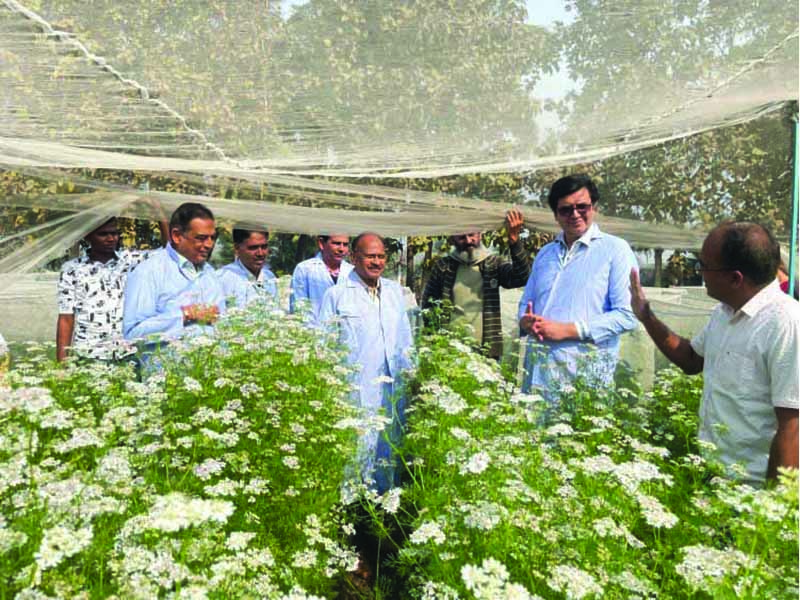In 2020, EducationWorld took the lead to rate and rank the country’s best government agricultural universities introducing and implementing best agriculture education practices

NAU’s ZP Patel (centre): impactful extension activities
With the Trump administration in the US determined to export American farm produce to India or else, the uncompetitiveness of India’s 195 million farmers is about to be exposed.
The stark truth is that India’s agriculture sector is in bad shape. Its contribution to the country’s GDP has declined from 35 percent in 1990-91 to 15 percent in 2022-23, while the percentage of population working in rural India is static at 60 percent. An estimated 400,000 farmers committed suicide due to agrarian distress between 1995-2018; average per hectare foodgrain yields are one-half of China’s, and the sector is plagued with obsolete farming practices and poor access to credit and irrigation facilities. Little wonder that the country’s rural majority is on the perpetual warpath demanding fair rural-urban terms of trade and in particular, legally guaranteed minimum support prices for agricultural produce.
A major contributory factor behind rural stagnation is poor quality of agriculture education. According to an essay in The Print (February 25), India’s agriculture sector is “stuck in the Green Revolution era” and “rigid curriculums fail to integrate contemporary issues like climate change, precision farming, and global market dynamics…, leaving students unprepared for challenges in modern agriculture”.
Though in 2021, the country’s apex-level Delhi-based Indian Council for Agricultural Research (ICAR, annual budget: Rs.10,450 crore) — an autonomous body promoted by the Central government way back in 1929 to “coordinate agricultural education and research” — revamped agriculture curriculums introducing courses on climate-resilient farming, biotechnology, agribusiness management, and AI, its 113 ivory tower ICAR institutes and 74 state government agricultural universities spread across the country are yet to implement them. Except for a handful of agri universities, most teach obsolete curriculums.
In 2020, EducationWorld took the lead to rate and rank the country’s best government agricultural universities introducing and implementing best agriculture education practices. And since 2022, ICAR’s flagship institute — ICAR Indian Agricultural Research Institute, Delhi (ICAR-IARI) — has been topping the league table of India’s best agri institutions.
This year is no different with the generously centrally-funded ICAR-IARI decisively ranked India’s #1 government agriculture varsity with top scores under the parameters of faculty competence, faculty welfare and development and research and innovation. But as usual, the ICAR-IARI top brass didn’t respond to our several emails and phone calls for interview.
Following ICAR-IARI is Punjab Agricultural University, Ludhiana at #2 and the Navsari Agricultural University at #3, both of whom have retained their 2024-25 ranks.
Beyond the Top 3, there’s been a minor reshuffle in seating order. Govind Ballabh Pant University of Agriculture & Technology, Pantnagar (Uttarakhand) and ICAR-National Dairy Research Institute, Karnal have traded their 2024-25 ranks with the former ranked #4 in 2025-26 (#5 in 2024-25) and the latter #5 (#4).
Chaudhary Charan Singh Haryana Agricultural University, Hisar has retained its #6 rank even as Junagadh Agricultural University (JAU) has slipped to #7 (#6) and ICAR – Indian Veterinary Research Institute, Izatnagar, Bareilly to #8 (#7). The Top 10 table is completed by the University of Agricultural Sciences, Bengaluru at #9 (#8) and Tamil Nadu Agricultural University, Coimbatore #10 (#9).
Dr. Z.P. Patel, the media-friendly Vice Chancellor of Navsari Agricultural University (NAU), promoted in 2004 by the Gujarat state government, is delighted that NAU has retained its Top 3 ranking in the 14-strong selective league table of the country’s best government agricultural universities with high scores under the parameters of curriculum and pedagogy, placement and range/diversity of programmes.
“This recognition is testament to our unwavering commitment to providing high quality agriculture education, farmer-oriented research, and impactful extension activities. NAU is one of the few agricultural universities in India that actively researches and develops cutting-edge technologies to serve the farming community and tech-savvy agripreneurs. Our high scores under the parameters of curriculum and pedagogy and placements are acknowledgement of the practical, real-time, entrepreneurship-oriented education we provide. However, our score for research and innovation under-estimates our excellent R&D initiatives. NAU has 26 research stations in 15 locations in Gujarat focusing on need-based fundamental, applied, and verification research on crops such as paddy, sugarcane, cotton, sorghum, small millets, mango, banana, sapota, and vegetables. We are the first institution in Gujarat to initiate research on biochar. Over the past five years, our commitment to research and innovation has led to 17 patents awarded to us,” says Dr. Patel.
Patel takes special pride in highlighting NAU’s farmer extension services. “We are very proud of our extension services provided by five Krishi Vigyan Kendras located across the state. We also strongly promote the farmer-to-farmer extension system, where a satisfied farmer becomes a catalyst for widespread adoption of innovative technologies. To upgrade our extension services, we have recently launched the ‘One Crop, One Village’ and ‘One Variety, One Village’ initiatives. Moreover, our vision includes identifying ‘One Scientist for One Crop’ across all disciplines, ensuring dedicated, in-depth research and development for every crop,” says Patel.